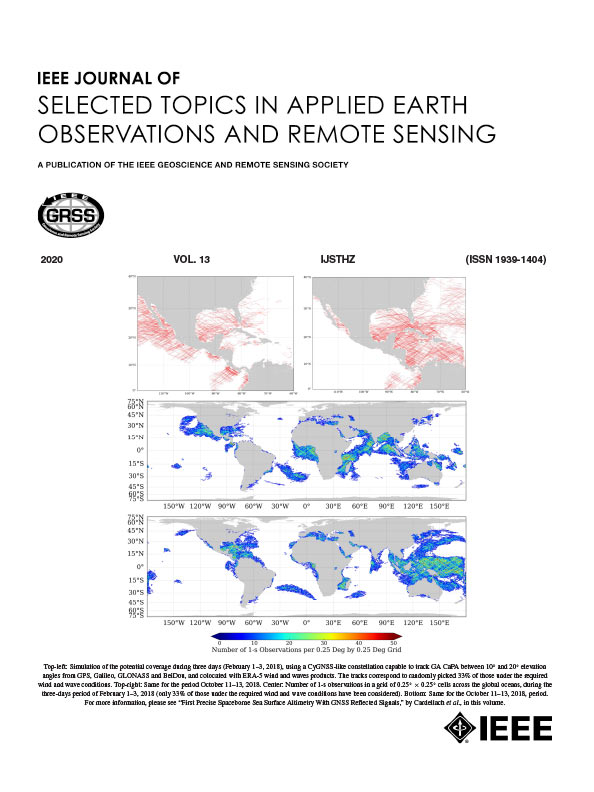Khatri-Rao Factorization Based Bi-Level Support Vector Machine for Hyperspectral Image Classification
IF 4.7
2区 地球科学
Q1 ENGINEERING, ELECTRICAL & ELECTRONIC
IEEE Journal of Selected Topics in Applied Earth Observations and Remote Sensing
Pub Date : 2025-03-31
DOI:10.1109/JSTARS.2025.3556351
引用次数: 0
Abstract
As a benchmark supervised learning algorithm, support vector machine (SVM) has drawn much attention and reported plenty of impressive results in hyperspectral images (HSIs) classification. It builds decision plane with soft margins to divide data into different classes. In previous studies, SVM usually employs a prepared spatial feature to improve its classification performance. Unlike those available where feature and classifier are separately designed, in this study, a bi-level joint optimization framework is developed to bridge SVM classifier training with Gabor feature learning. It is called bi-level support vector machine (BSVM). Inside BSVM, two data-oriented schemes are designed for further enhancement. First, it utilizes Khatri-Rao factorization to reshape the feature learning problem into tensor form which intends to break the feature factor matrix into small pieces and make the problem feasible in computation. Second, it embeds a local regularization term to promote discriminant ability. The normal vector of BSVM and feature factor matrices are solved by alternating iteration. BSVM is validated by extensive experiments on four popular HSI data sets. It achieves 76.10%, 82.84%, 89.04%, and 89.83% in classification accuracy on Houston 2018, Xiong'an, Houston 2013, and Indian Pines respectively, showing significantly improvement over the latest deep learning algorithms and proving its effectiveness and superiority.基于Khatri-Rao分解的双级支持向量机高光谱图像分类
作为一种基准监督学习算法,支持向量机(SVM)在高光谱图像(HSIs)分类方面备受关注,并取得了大量令人瞩目的成果。它利用软边际建立决策平面,将数据划分为不同的类别。在以往的研究中,SVM 通常采用准备好的空间特征来提高其分类性能。与现有的分别设计特征和分类器的方法不同,本研究开发了一种双层联合优化框架,将 SVM 分类器训练与 Gabor 特征学习结合起来。它被称为双层支持向量机(BSVM)。在 BSVM 中,设计了两个面向数据的方案以进一步增强其功能。首先,它利用 Khatri-Rao 因子化将特征学习问题重塑为张量形式,目的是将特征因子矩阵分成小块,使问题在计算上可行。其次,它嵌入了局部正则化项,以提高判别能力。BSVM 的法向量和特征因子矩阵通过交替迭代来求解。BSVM 在四个流行的人机交互数据集上进行了广泛的实验验证。在 Houston 2018、雄安、Houston 2013 和 Indian Pines 数据集上,BSVM 的分类准确率分别达到 76.10%、82.84%、89.04% 和 89.83%,与最新的深度学习算法相比有显著提高,证明了其有效性和优越性。
本文章由计算机程序翻译,如有差异,请以英文原文为准。
求助全文
约1分钟内获得全文
求助全文
来源期刊
CiteScore
9.30
自引率
10.90%
发文量
563
审稿时长
4.7 months
期刊介绍:
The IEEE Journal of Selected Topics in Applied Earth Observations and Remote Sensing addresses the growing field of applications in Earth observations and remote sensing, and also provides a venue for the rapidly expanding special issues that are being sponsored by the IEEE Geosciences and Remote Sensing Society. The journal draws upon the experience of the highly successful “IEEE Transactions on Geoscience and Remote Sensing” and provide a complementary medium for the wide range of topics in applied earth observations. The ‘Applications’ areas encompasses the societal benefit areas of the Global Earth Observations Systems of Systems (GEOSS) program. Through deliberations over two years, ministers from 50 countries agreed to identify nine areas where Earth observation could positively impact the quality of life and health of their respective countries. Some of these are areas not traditionally addressed in the IEEE context. These include biodiversity, health and climate. Yet it is the skill sets of IEEE members, in areas such as observations, communications, computers, signal processing, standards and ocean engineering, that form the technical underpinnings of GEOSS. Thus, the Journal attracts a broad range of interests that serves both present members in new ways and expands the IEEE visibility into new areas.

 求助内容:
求助内容: 应助结果提醒方式:
应助结果提醒方式:


